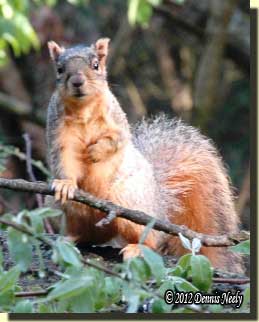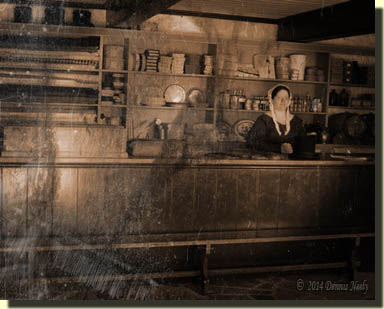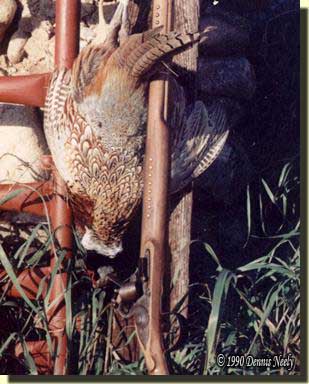Green oak leaves fluttered. Small branches bobbed and swayed a bit in the thinning canopy. Bright sunlight patches dappled and dotted the forest floor. The air smelled warm, humid and spring-like. Now and again a gentle breeze caressed the skin of haggard cheeks and rough hands, soothing the woodsman’s soul, beckoning a restful doze amidst the tranquility of that late-September afternoon.
A crimson cardinal ventured into this backcountry vignette, alighting low on a witch hazel sprig. The songster clutched the branch with spread legs as if hanging on for dear life. A distinctive chorus of “Whit, whit, tsu, tsu, tsu…” drifted among the hardwoods. Likewise, a blue jay hopped along an oak branch, above the cardinal. “Swip-it! Swip-it!” was its contented melody.
With tail stretched straight up, without regard to sunlight or shadows, a rambunctious chipmunk scurried the full length of a barkless oak trunk, about the girth of a powder keg. Then in the distance, up and over the rise to the east, a single, elusive cluck of a wild turkey betrayed that bird’s existence on the woodland stage.
The woodsman’s chin scrunched up. A subtle nod followed. Eager fingers slipped under the deerskin flap of the post hunter’s shot pouch, then searched the front fold for the wing-bone call. The flatter end of the creamy-white bone touched dry lips; cupped hands muffled the rounder end as a soft draw of air added a subdued yet clear “Aarrkkk” to the afternoon’s symphony.
The Northwest trade gun’s muzzle eased eastward; leather-clad legs shifted that way, too. Anticipation and backcountry life lessons dictated a modest accommodation to the possibility of a wild turkey strolling into the glade from that direction.
 The chipmunk twittered as it ran along a downed branch, then disappeared. A fox squirrel barked, up high, unseen and many trees distant. Minutes melted away like old snow fading on an overly warm March afternoon. The cardinal was gone, but a blue jay remained—perhaps not the same bird.
The chipmunk twittered as it ran along a downed branch, then disappeared. A fox squirrel barked, up high, unseen and many trees distant. Minutes melted away like old snow fading on an overly warm March afternoon. The cardinal was gone, but a blue jay remained—perhaps not the same bird.
About the time two chickadees visited, brown fur passed from shadow to sunlight. White tines flashed, then vanished. A chipping sparrow perched on the same witch hazel sprig used by the cardinal, but the movement farther out on the doe trail captivated the moment. North to south, the first-year, six-point buck walked. The Northwest gun’s death bees fidgeted, but held no power on that afternoon, in the Year of our Lord, 1796.
Balancing “Modern” vs. “Historical”
That history-based scenario was a wild turkey chase, pure and simple. By Michigan’s game laws, hunting fox squirrels required “a cap, hat, vest, jacket, or rain gear of hunter orange.” In truth, a hunter-orange, silk scarf, rumpled up and tucked inside the front fold of the post hunter’s caped, linen outer shirt, was available to switch with the green headscarf. But my alter ego had no desire to do so.
Further, the young buck represented a period-correct opportunity to put meat on the table in an 18th-century sense, but within the confines of the 21st century, deer season wouldn’t open for another six weeks. Traditional black powder hunters are, after all, respectful of the wild game they pursue and the modern rules and regulations that guide scientific natural resource management.
 There is no indication from Outarde as to how he hunted or why he provided the game that he did for Sayer’s trading post. One explanation is that the variety of game was governed by where he hunted and what game presented itself when afield.
There is no indication from Outarde as to how he hunted or why he provided the game that he did for Sayer’s trading post. One explanation is that the variety of game was governed by where he hunted and what game presented itself when afield.
Eighteenth-century hunting methods and ethics vary from today. For example, the number of ducks brought to the trading post by the different hunters sometimes draws questions. We think of one shot per duck or goose, taken while flying. In that era, shooting ducks at rest on a pond was an economical means of securing multiple morsels with a single shot. John Tanner alludes to this method in this passage:
“As I was one day going to look at my traps, I found some ducks in a pond, and taking the ball out of my gun, I put in some shot, and began to creep up to them…” (Tanner, 60)
One of the other points gained from Outardes game bag is the mix of game. Again, John Tanner helps us understand that in 18th-century terms, gathering the most meat with the least amount of effort was common practice:
“As I was crawling cautiously through the bushes [stalking the above ducks on the pond], a bear started up near me, and ran into a white pine tree almost over my head. I hastily threw a ball into my gun and fired…” (Ibid)
Throughout the ensuing months the post hunters supply bear, muskrats and beaver, in addition to the other game. What seems to be missing from Sayer’s journal that appears in many other clerks’ entries are moose and elk. The question that comes to mind is, “Did Sayers lump these animals all into one category, ‘deer’—or were there only white-tailed deer in that area?” Perhaps this is a side discussion best left for a later date?
The problem that arises, if one wants to call it that, is how do you create a scenario that allows for the taking of game as it is presented, given modern game laws? To be true to the journal passages, on that late-September afternoon in 1796 all game should be available for the taking—again, in a historical sense.
Following Tanner’s example, the post hunter should have/could have pulled the turkey load, added a round ball and shot the six-point buck, as long as that amount of movement did not spook the buck off. Viewed from yesteryear, the choice was simple: a couple pounds of wild turkey flesh versus a hundred-weight, or there about, of venison.
There are, of course, fall time frames when most game is in season. Additional rules, such as using non-toxic shot and not carrying round balls when waterfowl hunting, dictate how a smoothbore gets stoked.
 When ring-necked pheasants were plentiful on the North-Forty and waterfowl season was also open, the death bees were bismuth, not lead. I can recall a number of times when wood ducks jumped from the nameless creek that flowed beside some of the best pheasant habitat on the farm. Likewise, a fine rooster pheasant came to the table on more than one occasion when an intended stalk of the duck marsh took an unexpected turn.
When ring-necked pheasants were plentiful on the North-Forty and waterfowl season was also open, the death bees were bismuth, not lead. I can recall a number of times when wood ducks jumped from the nameless creek that flowed beside some of the best pheasant habitat on the farm. Likewise, a fine rooster pheasant came to the table on more than one occasion when an intended stalk of the duck marsh took an unexpected turn.
In today’s world, the post hunter does not have to arrive at the homestead door with thirty ducks or four deer or a half dozen geese. Such a need for meat is not that pressing or urgent. But that said, over the last forty years as a traditional black powder hunter, there have been several occasions when the taking of multiple critters became a reality, mostly with small game or waterfowl.
In the case of white-tailed deer, multiple harvests by one individual are contrary to our game management plan and the ethics associated with spreading the blessing of fresh venison among all family members who wish to hunt.
Sometimes the historical record tweaks the curiosity of a traditional woodsman. Meshach Browning tells of betting his hunting buddies that he can kill two deer in a day. As the hunt played out, Browning killed six deer (Browning, 168 – 173). Well, that story got to me, and I set out to see what I could do, still within the game laws, carrying an empty smoothbore.
When a deer, either buck or doe, come within “Old Turkey Feather’s” effective distance, I took aim, and at the appropriate instant said, “BANG!” quite loud. If I came upon more than one deer, all ran when I yelled, which duplicated the resulting flight after a single muzzle blast. I allowed an hour for tracking or skinning as Browning described. By the end of an afternoon, I “killed” four deer, but more important, I came away with an exhilarating feeling of having experienced what Browning accomplished.
By following Sayer’s dealings with Outarde, a living historian bent on the simple pursuit can come away with a better understanding of what a post hunter really did. A hired hunter for a trading post was just that, a hired hunter. This was an 18th-century occupation, a professional hunter who supplied meat for multiple people, not just his family. The mindset is different. A glimpse of that mindset is only gained by walking in that person’s moccasins, or better said, by hunting in that person’s moccasins…
Give traditional black powder hunting a try, be safe and may God bless you.



One Response to Hunting in that person’s moccasins…